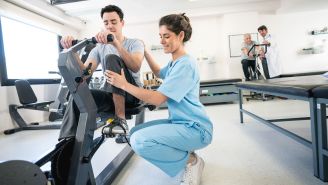Updated on August 13, 2024.
When you think of a heart attack, symptoms like chest pain and shortness of breath probably come to mind. But that’s not always the case for women. In fact, many women don’t even realize they’re having a heart attack.
“People are expecting the classical chest pain,” says Atiq Rehman, MD, a cardiothoracic surgeon in Columbus, Ohio. They may believe that if they don’t have that symptom, then it’s not a heart attack, he adds. “But in real life, that’s not so.”
If the symptoms are “atypical,” or unusual, women may not seek medical care as fast as they should. In these cases, the implications can be more severe, Dr. Rehman says.
Heart attack symptoms in women have been misunderstood
A heart attack happens when blood flow to the heart gets blocked. This is most often the result of either undiagnosed or untreated heart disease. The sooner you seek treatment, the better your chance of surviving.
Healthcare providers (HCPs) and laypeople alike often consider heart attack symptoms that men normally experience as “typical” or “classic.” Symptoms that are more common in women, meanwhile, are often considered “atypical.” But that’s largely a function of how medical science has been done in the past.
Heart disease research and awareness in women has lagged
Because researchers for a long time assumed incorrectly that heart disease was a “man’s disease,” most initial studies of heart disease focused on men. Women were assumed to have some sort of natural protection against heart disease until they went through menopause. It was believed that taking hormone therapy after menopause could recreate that protective factor.
In 1977, the U.S. Food and Drug Administration issued a guideline that banned women of childbearing age from participating in clinical trials. The intention was to protect them and unborn children from potential risks. But that protection came at the cost of neglecting comprehensive research into heart disease in women.
The FDA canceled the ban in 1993 and that same year, Congress passed a law known as “Women and Minorities as Subjects in Clinical Research” to ensure that these groups are better represented in studies.
Despite these efforts, women continued to be underrepresented in clinical trials. They also continued to be counseled by HCPs less often than men on preventive, heart-healthy practices and on the symptoms (or lack of symptoms) of heart attacks.
To address that disparity, the American Heart Association (AHA) launched a campaign to increase awareness of heart disease. As a result, the percent of women who understood the risk of heart disease increased from 7 percent in 1997 to 44 percent in 2019.
It’s thus been only relatively recently that heart disease in women has received adequate scientific focus and public attention. There is still a long way to go toward parity.
Heart attack symptoms to spot in both women and men
No matter their sex, when people have a heart attack, they tend to experience these typical symptoms:
- Chest pain and/or pressure
- Shortness of breath
- Discomfort in the arm, shoulder, neck, or back
When women have a heart attack, they are likely to have chest pain and discomfort, but they don’t always have these symptoms. Instead, they are more likely than men to report other symptoms, including:
- Nausea and vomiting
- Back or jaw pain
- Sweating
- Pressure or pain in the lower chest or upper abdomen
- Dizziness, lightheadedness, or fainting
- Extreme fatigue
- Heartburn or indigestion
When experienced by women, these symptoms might feel particularly intense. Women may also have the symptoms while asleep or resting or during periods of emotional stress.
Why women experience different symptoms
Experts don’t know for sure why women have different heart attack symptoms. But research has turned up some important differences in the way men and women develop heart disease that may provide some explanation.
Women, especially younger women, tend to develop blockages in not just the major arteries, but also in the smaller blood vessels that take blood to the heart. This is a condition called small vessel heart disease. Women who have high blood pressure before going through menopause, and those who experience irregular or severe menopause symptoms, are also more likely to have small vessel heart disease.
Women who have diabetes are more likely than men with diabetes to have heart disease. This may change their experience of a heart attack, since diabetes can change pain perception. People with diabetes may also have atypical heart attack symptoms or no symptoms at all.
Similarly, smoking seems to put women at higher risk of heart disease than men. Family history of heart disease at a young age also heavily affects women compared to men. And complications experienced during pregnancy may raise the risk of high blood pressure, diabetes, and heart disease.
Psychosocial factors may also play a role
Certain aspects of life may also distract someone from the signs of a heart attack. “If you have multiple distractions like work, family, and kids, all that creates anxiety, stress, or depression, which may mask classical symptoms of a heart attack,” says Rehman.
Women may assume their symptoms are caused by stress, or something else, and delay getting help. They may also expect not to be taken seriously in medical environments, or they may ignore their symptoms entirely. And women’s hearts are more heavily affected by emotional stress and depression than men’s are.
Members of racial and ethnic groups have different levels of heart attack risk. Of all women in the United States, Black women have the highest rates of coronary artery disease, stroke, high blood pressure, and heart failure. They are also underrepresented in clinical studies. Stress that results from the daily experience of encountering structural racism also plays a large role in the health of women of color.
Other serious social issues can add to women’s general and cardiovascular stress. These may include a lack of access to vital resources, such as healthy food or health care.
Healthcare providers treat women differently
Although treatments for heart disease—such as coronary bypass surgery, angioplasty, stenting, and medications—are generally identical for men and women, HCPs have been found in some cases to treat men and women differently.
For example, women are not offered certain preventive treatments as often as men are. These include cholesterol-lowering drugs like statins, or aspirin, which may be used to help reduce the risk of having a second heart attack. Women may also be referred less often than men to cardiac rehabilitation programs, which are important for recovering from heart disease.
And women have a lower chance of having coronary bypass surgery. This might be at least in part because women tend to have more small vessel disease rather than large obstructions in major arteries.
HCPs may also often feel uncertain about women’s special cardiac risk factors. This may even apply to HCPs who specialize in hearts. According to the AHA, only 42 percent of cardiologists feel their training has sufficiently prepared them to evaluate women for cardiovascular risks.
Due in part to differences in preventive care and in treatments, the rates of hospitalization from heart attacks for women over 55 have gone up, while rates for men over 55 have gone down. Women are also at a higher risk of death from a heart attack.
Keys to prevention
Women don’t need to wait for the science to catch up before taking steps to protect themselves from heart disease. It starts with awareness.
“The first thing women need to understand is that heart disease is your number-one killer. It can happen to anyone,” says Rehman.
While there are certain risk factors for heart disease you can’t control, like genetics, there are plenty of things you can do to lower your chances.
“You need to maintain a healthy lifestyle,” says Rehman. “Avoid smoking, drink in moderation or avoid drinking. If you have high blood pressure or diabetes, make sure it’s controlled. And be sure to exercise.”
To protect your heart during a potential health crisis, listen to your body. If something feels off and you think you might possibly be having a heart attack, don’t delay. Call 911.







